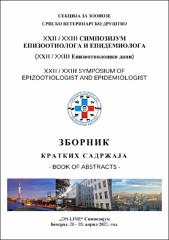Aktuelne strategije za prevenciju i kontrolu infektivnih bolesti slatkovodnih riba

View/
Date
2021-04-26Author
Novakov, Nikolina
Labus, Tatjana
Rogan, Dragan
Potkonjak, Aleksandar
Radosavljević, Vladimir
Lazić, Dušan
Pelić, Miloš
Ćirković, Miroslav
Metadata
Show full item recordAbstract
Aquaculture represents a branch of the economy with large annually production at a rate of approximately 9.6% worldwide. One of the major limiting factors for the further growth and development of aquaculture are fish diseases, especially viral. In the Republic of Serbia, fish from the families of Cyprinidae and Salmonidae predominate in aquaculture, and the control of koi herpesvirus disease and spring viremia of carp is currently the biggest challenge. For this reason, present paper aims to outline the various preventive and therapeutic methods available in the prophylaxis and control of infectious diseases in freshwater fish. Many elements including the supply of spawn fish for artificial spawning to the supply of fingerlings to ponds should be controlled, as this is a very common way of transmitting disease from one fish farm to another. Of course, the possibility of vaccination and administration of immunostimulants as well as probiotics and prebiotics should be considered. In bacterial infections, the use of antibiotics is one of the most common ways to control certain diseases. Biosecurity measures are very important to prevention, especially disinfection, which involves the use of different preparations depending on the type of the objects and fish species being farmed. In general, active surveillance should be worked on, as well as adequate disease planning strategies based dominantly on biosecurity measures.
